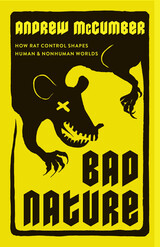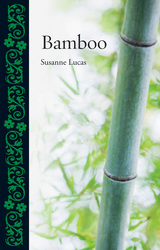3 books about Lobo, Susan
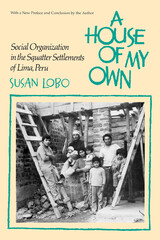
A House of My Own
Social Organization in the Squatter Settlements of Lima, Peru
Susan Lobo
University of Arizona Press, 1982
"A fairly comprehensive monograph, highly suitable for classroom use, that offers a wide range of information fit into traditional anthropological categories. . . . an interesting study of cultural integrity and pattern in a setting of what appears to be complex sociopolitical chaos." —American Anthropologist
"Whether or not one accepts Susan Lobo's optimistic analysis, her ability to translate the apparent chaos of shanty-town lives into such neat patterns and to help outsiders view life as the inhabitants do are important contributions." —Inter-American Review of Bibliography
"An extremely competent ethnography, simple and straightforward." —Anthropos
"A pleasure to read, a mine of information which will be useful in teaching students to formulate their own hypotheses." —International Journal of Urban & Regional Research
"Very well written and provides a great wealth of the liveliest sort of ethnographic detail." —Latin American Research Review
"Lobo's study of two squatter settlements in Lima provides a solid, well-written, detailed, traditional ethnography of poor families in a Third World urban setting." —Hispanic American Historical Review
"This well-written account . . . has a lot of heart and feeling for the human face of the urban poor." —International Migration Review
"Whether or not one accepts Susan Lobo's optimistic analysis, her ability to translate the apparent chaos of shanty-town lives into such neat patterns and to help outsiders view life as the inhabitants do are important contributions." —Inter-American Review of Bibliography
"An extremely competent ethnography, simple and straightforward." —Anthropos
"A pleasure to read, a mine of information which will be useful in teaching students to formulate their own hypotheses." —International Journal of Urban & Regional Research
"Very well written and provides a great wealth of the liveliest sort of ethnographic detail." —Latin American Research Review
"Lobo's study of two squatter settlements in Lima provides a solid, well-written, detailed, traditional ethnography of poor families in a Third World urban setting." —Hispanic American Historical Review
"This well-written account . . . has a lot of heart and feeling for the human face of the urban poor." —International Migration Review
[more]
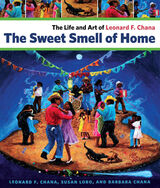
The Sweet Smell of Home
The Life and Art of Leonard F. Chana
Leonard F. Chana, Susan Lobo, and Barbara Chana
University of Arizona Press, 2009
A self-taught artist in several mediums who became known for stippling, Leonard Chana captured the essence of the Tohono O’odham people. He incorporated subtle details of O’odham life into his art, and his images evoke the smells, sounds, textures, and tastes of the Sonoran desert—all the while depicting the values of his people.
He began his career by creating cards and soon was lending his art to posters and logos for many community-based Native organizations. Winning recognition from these groups, his work was soon actively sought by them. Chana’s work also appears on the covers and as interior art in a number of books on southwestern and American Indian topics.
The Sweet Smell of Home is an autobiographical work, written in Chana’s own voice that unfolds through oral history interviews with anthropologist Susan Lobo. Chana imparts the story of his upbringing and starting down the path toward a career as an artist. Balancing humor with a keen eye for cultural detail, he tells us about life both on and off the reservation.
Eighty pieces of art—26 in color—grace the text, and Chana explains both the impetus for and the evolution of each piece. Leonard Chana was a people’s artist who celebrated the extraordinary heroism of common people’s lives. The Sweet Smell of Home now celebrates this unique artist whose words and art illuminate not only his own remarkable life, but also the land and lives of the Tohono O’odham people
He began his career by creating cards and soon was lending his art to posters and logos for many community-based Native organizations. Winning recognition from these groups, his work was soon actively sought by them. Chana’s work also appears on the covers and as interior art in a number of books on southwestern and American Indian topics.
The Sweet Smell of Home is an autobiographical work, written in Chana’s own voice that unfolds through oral history interviews with anthropologist Susan Lobo. Chana imparts the story of his upbringing and starting down the path toward a career as an artist. Balancing humor with a keen eye for cultural detail, he tells us about life both on and off the reservation.
Eighty pieces of art—26 in color—grace the text, and Chana explains both the impetus for and the evolution of each piece. Leonard Chana was a people’s artist who celebrated the extraordinary heroism of common people’s lives. The Sweet Smell of Home now celebrates this unique artist whose words and art illuminate not only his own remarkable life, but also the land and lives of the Tohono O’odham people
[more]
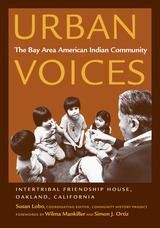
Urban Voices
The Bay Area American Indian Community
Susan Lobo, Coordinating Editor, Community History Project; Forewords by Wilma Mankiller and Simon J. Ortiz
University of Arizona Press, 2002
California has always been America's promised land—for American Indians as much as anyone. In the 1950s, Native people from all over the United States moved to the San Francisco Bay Area as part of the Bureau of Indian Affairs Relocation Program. Oakland was a major destination of this program, and once there, Indian people arriving from rural and reservation areas had to adjust to urban living. They did it by creating a cooperative, multi-tribal community—not a geographic community, but rather a network of people linked by shared experiences and understandings. The Intertribal Friendship House in Oakland became a sanctuary during times of upheaval in people's lives and the heart of a vibrant American Indian community. As one long-time resident observes, "The Wednesday Night Dinner at the Friendship House was a must if you wanted to know what was happening among Native people." One of the oldest urban Indian organizations in the country, it continues to serve as a gathering place for newcomers as well as for the descendants of families who arrived half a century ago. This album of essays, photographs, stories, and art chronicles some of the people and events that have played—and continue to play—a role in the lives of Native families in the Bay Area Indian community over the past seventy years. Based on years of work by more than ninety individuals who have participated in the Bay Area Indian community and assembled by the Community History Project at the Intertribal Friendship House, it traces the community's changes from before and during the relocation period through the building of community institutions. It then offers insight into American Indian activism of the 1960s and '70s—including the occupation of Alcatraz—and shows how the Indian community continues to be created and re-created for future generations. Together, these perspectives weave a richly textured portrait that offers an extraordinary inside view of American Indian urban life. Through oral histories, written pieces prepared especially for this book, graphic images, and even news clippings, Urban Voices collects a bundle of memories that hold deep and rich meaning for those who are a part of the Bay Area Indian community—accounts that will be familiar to Indian people living in cities throughout the United States. And through this collection, non-Indians can gain a better understanding of Indian people in America today. "If anything this book is expressive of, it is the insistence that Native people will be who they are as Indians living in urban communities, Natives thriving as cultural people strong in Indian ethnicity, and Natives helping each other socially, spiritually, economically, and politically no matter what. I lived in the Bay Area in 1975-79 and 1986-87, and I was always struck by the Native (many people do say 'American Indian' emphatically!) community and its cultural identity that has always insisted on being second to none. Yes, indeed this book is a dynamic, living document and tribute to the Oakland Indian community as well as to the Bay Area Indian community as a whole." —Simon J. Ortiz "When my family arrived in San Francisco in 1957, the people at the original San Francisco Indian Center helped us adjust to urban living. Many years later, I moved to Oakland and the Intertribal Friendship House became my sanctuary during a tumultuous time in my life. The Intertribal Friendship House was more than an organization. It was the heart of a vibrant tribal community. When we returned to our Oklahoma homelands twenty years later, we took incredible memories of the many people in the Bay Area who helped shape our values and beliefs, some of whom are included in this book." —Wilma Mankiller, former Principal Chief, Cherokee Nation
[more]
READERS
Browse our collection.
PUBLISHERS
See BiblioVault's publisher services.
STUDENT SERVICES
Files for college accessibility offices.
UChicago Accessibility Resources
home | accessibility | search | about | contact us
BiblioVault ® 2001 - 2025
The University of Chicago Press




